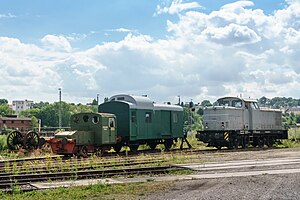Deutz MLH 232 R
| Deutz MLH 232 R | |
|---|---|
|
Railway depot Gera with preserved ML 232 R
|
|
| Number: | 26th |
| Manufacturer: | Deutz |
| Year of construction (s): | 1926-1929 |
| Retirement: | until 2011 |
| Axis formula : | B. |
| Gauge : | 1435 mm ( standard gauge ) |
| Length over buffers: | 5,330 mm |
| Length: | 4,230 mm |
| Height: | 2,800 mm |
| Width: | 2,800 mm |
| Total wheelbase: | 1,600 mm |
| Empty mass: | 10.1 t |
| Service mass: | 10.3 t |
| Friction mass: | 10.3 t |
| Wheel set mass : | 5.15 t |
| Top speed: | 8 km / h |
| Installed capacity: | 16.2 kW (22 hp) |
| Motor type: | Deutz MLH 232 R |
| Motor type: | Single cylinder four-stroke diesel engine |
| Rated speed: | 400 rpm |
| Power transmission: | mechanically |
| Brake: | Handbrake |
The Deutz MLH 232 R was a two-axle diesel locomotive with rod drive , which was designed for light shunting with the Deutz MLH 232 R engine series . Deutz built 26 of them in 1926 . Some locomotives have been preserved, such as the one in the historic Gera depot with the factory number Deutz 9586 .
development
In contrast to the Lanz Bulldog brand tractors manufactured since 1921, a single-cylinder four-stroke diesel engine was used in the conceptually similar rail vehicles from Deutz from around 1925. In the machines designed, the engine designation was also used to designate the locomotive for the first time. The letters MLH ML meant a horizontally arranged single-cylinder four-stroke engine, with H designating the diesel engine. In the works catalog of Deutz, the immediate readiness for operation, the simple operation, the saving of the heater and the smoke- and odor-free exhaust were given as advertising arguments compared to the steam locomotives that were still predominant for shunting operations at that time. From 1926 to 1929, 26 locomotives were built that were used on connecting railways.
technology
The series of locomotives, designed as front-mounted locomotives, with the characteristic round cab windows based on the model of steam locomotives, was powered by a slow-running single-cylinder four-stroke diesel engine with direct injection, which was powered by crude oil. The output was around 22 hp (16 kW) at 400 rpm. The engine was started with compressed air, for which the locomotive had a compressed air bottle on the engine front. The power was transferred to the rear drive axle through a clutch via a mechanical two-speed gearbox with connected reversing gear and chains, the front drive axle was driven with coupling rods. The largest trailer load was specified on a flat and straight stretch of 220 t. In curves, the performance was given as 163 t at 3.5 km / h. The locomotive only had a quick-acting throw lever brake as a brake , and there was a sand spreader to increase the friction force. Upon request, the locomotive could also be equipped with a shunting winch.
commitment
The large number of manufactured locomotives and the long service life of individual examples show that the locomotives have proven themselves in operation. The last machine manufactured in 1929 with the serial number 9586 , which was delivered to a malt factory in Könnern and was at home until the factory was demolished in 1991, has been preserved. After being passed on to another malt factory in Landsberg , the locomotive was loaned to Gera Railway Worlds in 2011 .
literature
- Klaus-Joachim Schrader: Deutz ML 232 diesel shunting locomotive . In: Die Kleinbahn: Privatbahnen & Werkbahnen . No. 4/1991 . Ingrid Zeunert, 1991, ISSN 0177-4786 , p. 64-65 .
Web links
- Data sheet about the Deutz MLH 232 R locomotives at www.rangierdiesel.de
- Data sheet on Deutz locomotives of the ML series at www.rangierdiesel.de
- Data sheet about the engines of the Deutz MLH 232 R locomotives at www.Lokmacher.de
Individual evidence
- ↑ a b Data record from the Deutz 9586 locomotive on rangierdiesel.de
- ↑ Data set from the Deutz ML series locomotives on rangierdiesel.de
- ↑ Description of the engine series at www.Lokmacher.de
- ↑ a b Data record of the manufactured Deutz MLH series 232 R locomotives on rangierdiesel.de
- ↑ a b Klaus-Joachim Schrader: Deutz ML 232 diesel shunting locomotive . In: Die Kleinbahn: Privatbahnen & Werkbahnen . No. 4/1991 . Ingrid Zeunert, 1991, ISSN 0177-4786 , p. 64-65 .
